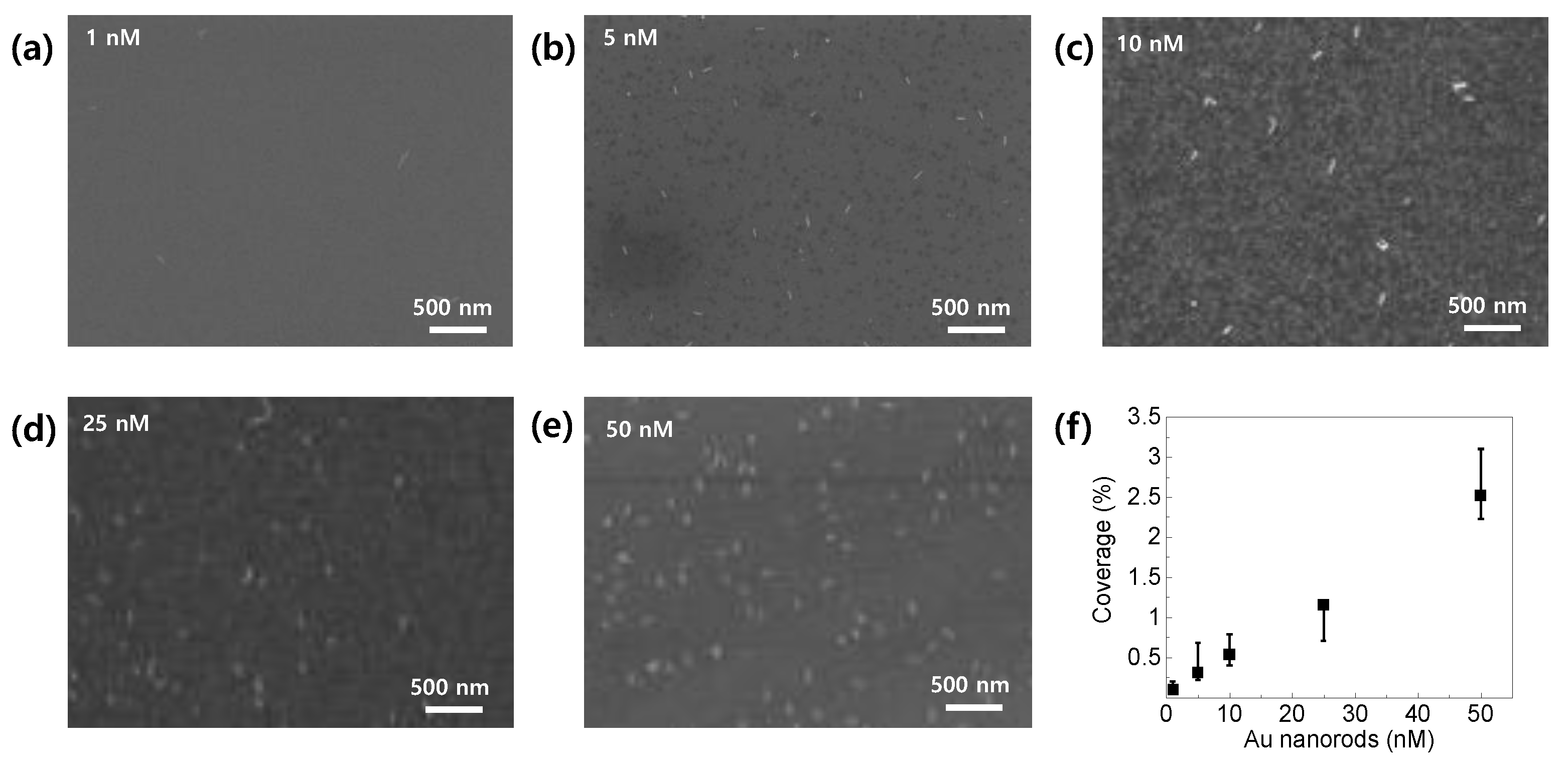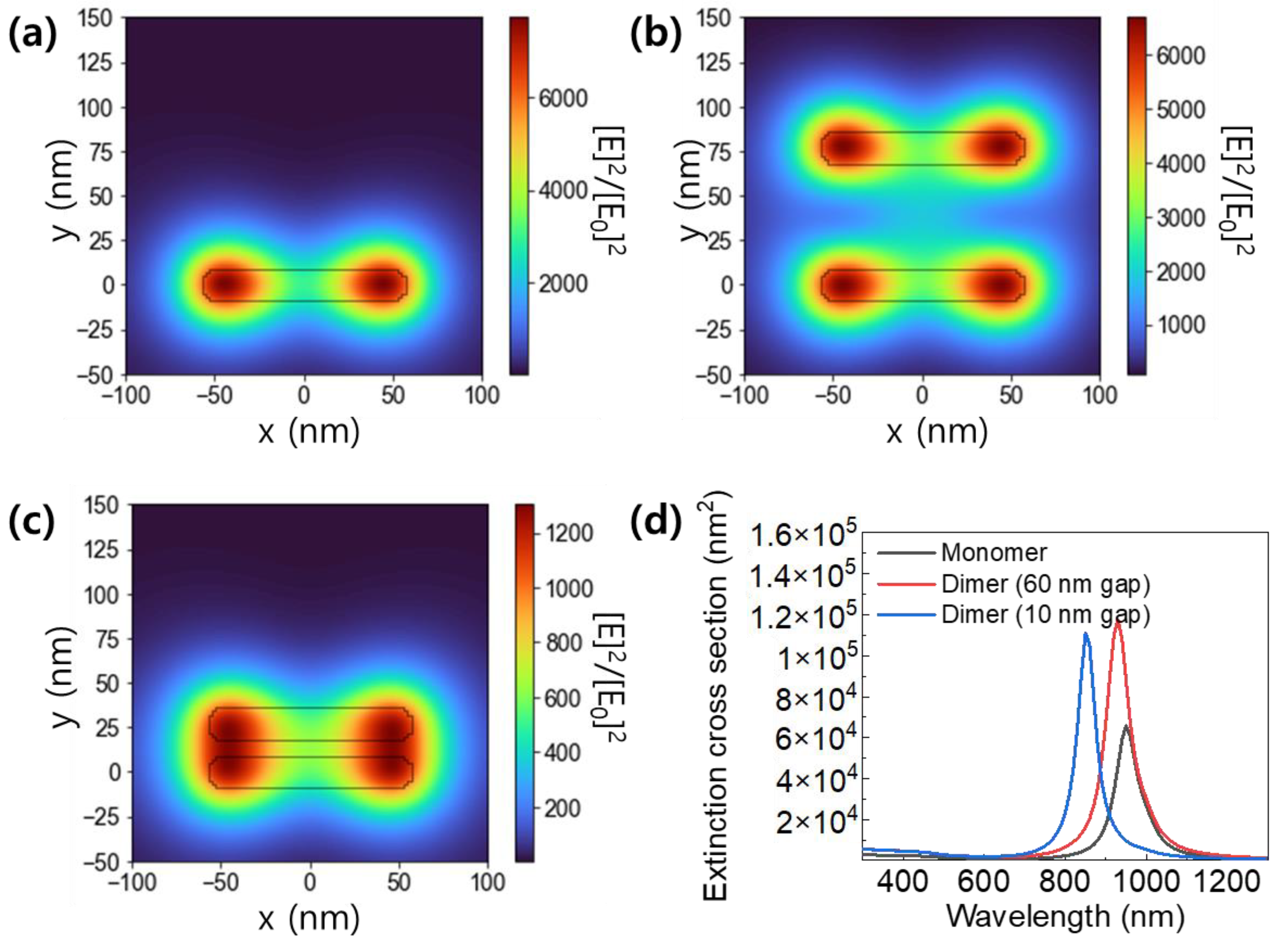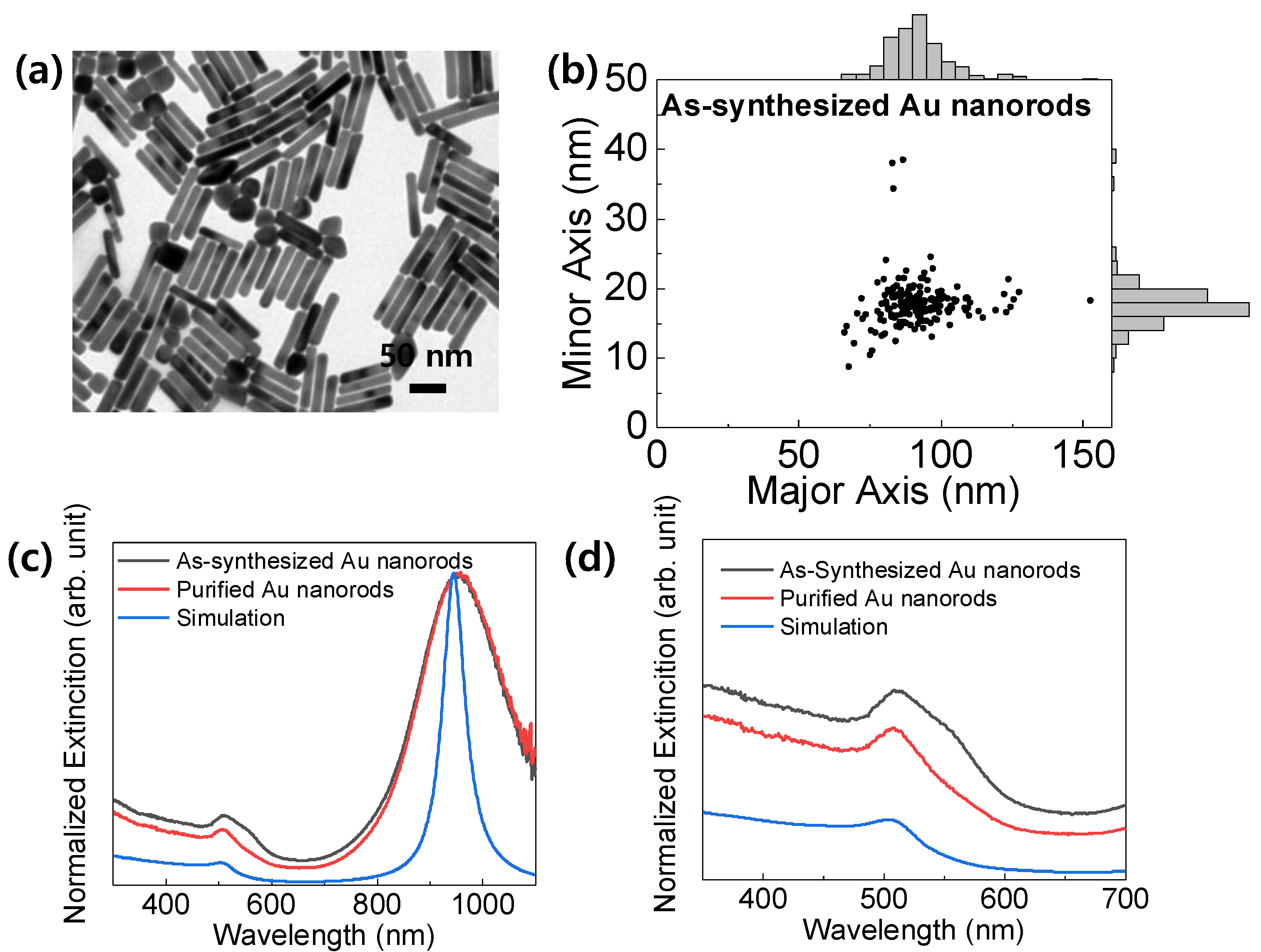Photocurrent Enhancement of PtSe2 Photodetectors by Using Au Nanorods
Abstract
:1. Introduction
2. Materials and Methods
3. Results & Discussion
4. Conclusions
Supplementary Materials
Author Contributions
Funding
Institutional Review Board Statement
Informed Consent Statement
Conflicts of Interest
References
- Rozlosnik, A. Potential Contribution of the Infrared Industry in the Future of IoT/IIoT. In Proceedings of the 14th Quantitative Infrared Thermography Conference, Berlin, Germany, 25–29 June 2018; pp. 194–208. [Google Scholar] [CrossRef]
- Chetan, N.B.; Gong, J.; Zhou, H.; Bi, D.; Lan, J.; Qie, L. An Overview of Recent Progress of Lane Detection for Autonomous Driving. In Proceedings of the 6th International Conference on Dependable Systems and Their Applications, Harbin, China, 3–6 January 2020; pp. 341–346. [Google Scholar] [CrossRef]
- Maruyama, T.; Narusawa, F.; Kudo, M.; Tanaka, M.; Saito, Y.; Nomura, A. Development of a Near-Infrared Photon-Counting System Using an InGaAs Avalanche Photodiode. Opt. Eng. 2002, 41, 395. [Google Scholar] [CrossRef]
- Bone, P.A.; Ripalda, J.M.; Bell, G.R.; Jones, T.S. Surface Reconstructions of InGaAs Alloys. Surf. Sci. 2006, 600, 973–982. [Google Scholar] [CrossRef] [Green Version]
- Moazzami, K.; Phillips, J.; Lee, D.; Krishnamurthy, S.; Benoit, G.; Fink, Y.; Tiwald, T. Detailed Study of Above Bandgap Optical Absorption in HgCdTe. J. Electron. Mater. 2005, 34, 773–778. [Google Scholar] [CrossRef]
- Arias, J.M.; Pasko, J.G.; Zandian, M.; Kozlowski, L.J.; DeWames, R.E. Molecular Beam Epitaxy HgCdTe Infrared Photovoltaic Detectors. Opt. Eng. 1994, 33, 1422. [Google Scholar] [CrossRef]
- Kinch, M.A.; Borrello, S.R.; Simmons, A. 0.1 eV HgCdTe Photoconductive Detector Performance. Infrared Phys. 1977, 17, 127–135. [Google Scholar] [CrossRef]
- Ashcroft, A.; Baker, I. Developments in HgCdTe Avalanche Photodiode Technology and Applications. In Proceedings of the SPIE Defense, Security, and Sensing, Orlando, FL, USA, 5–9 April 2010; Volume 7660, p. 76603C. [Google Scholar] [CrossRef]
- Tchounwou, P.B.; Yedjou, C.G.; Patlolla, A.K.; Sutton, D.J. Heavy Metals Toxicity and the Environment Paul. Mol. Clin. Environ. Toxicol. 2012, 101, 133–164. [Google Scholar] [CrossRef]
- Taylor, A. Biochemistry of Tellurium. Biol. Trace Elem. Res. 1996, 55, 231–239. [Google Scholar] [CrossRef]
- European Commission Waste Electrical & Electronic Equipment Directive 2011/65/EU of the European Parliament and of the Council of 8 June 2011 on the restriction of the Use of Certain Hazardous Substances in Electrical and Electronic Equipment Text with EEA Relevance. Off. J. Eur. Union 2011, 1, 88–110.
- Tang, W.; Rassay, S.; Ravindra, N. Electronic & Optical properties of transition-metal dichalcogenides. Madridge J. Nanotechnol. Nanosci. 2017, 2, 59–65. [Google Scholar] [CrossRef]
- Xie, Y.; Zhang, B.; Wang, S.; Wang, D.; Wang, A.; Wang, Z.; Yu, H.; Zhang, H.; Chen, Y.; Zhao, M.; et al. Ultrabroadband MoS2 Photodetector with Spectral Response from 445 to 2717 nm. Adv. Mater. 2017, 29. [Google Scholar] [CrossRef]
- Chang, Y.H.; Zhang, W.; Zhu, Y.; Han, Y.; Pu, J.; Chang, J.K.; Hsu, W.T.; Huang, J.K.; Hsu, C.L.; Chiu, M.H.; et al. Monolayer MoSe2 Grown by Chemical Vapor Deposition for Fast Photodetection. ACS Nano 2014, 8, 8582–8590. [Google Scholar] [CrossRef] [PubMed] [Green Version]
- Tan, H.; Fan, Y.; Zhou, Y.; Chen, Q.; Xu, W.; Warner, J.H. Ultrathin 2D Photodetectors Utilizing Chemical Vapor Deposition Grown WS2 with Graphene Electrodes. ACS Nano 2016, 10, 7866–7873. [Google Scholar] [CrossRef] [PubMed]
- Zheng, Z.; Zhang, T.; Yao, J.; Zhang, Y.; Xu, J.; Yang, G. Flexible, Transparent and Ultra-Broadband Photodetector Based on Large-Area WSe2 Film for Wearable Devices. Nanotechnology 2016, 27, 225501. [Google Scholar] [CrossRef] [PubMed]
- Manzeli, S.; Ovchinnikov, D.; Pasquier, D.; Yazyev, O.V.; Kis, A. 2D Transition Metal Dichalcogenides. Nat. Rev. Mater. 2017, 2, 17033. [Google Scholar] [CrossRef]
- Zhuang, H.L.; Hennig, R.G. Computational Search for Single-layer Transition-Metal Dichalcogenide Photocatalysts. J. Phys. Chem. C 2013, 117, 20440–20445. [Google Scholar] [CrossRef]
- Wang, Y.; Li, L.; Yao, W.; Song, S.; Sun, J.T.; Pan, J.; Ren, X.; Li, C.; Okunishi, E.; Wang, Y.Q.; et al. Monolayer PtSe2, a New Semiconducting Transition-Metal-Dichalcogenide, Epitaxially Grown by Direct Selenization of Pt. Nano Lett. 2015, 15, 4013–4018. [Google Scholar] [CrossRef]
- Wang, L.; Zhang, S.; McEvoy, N.; Sun, Y.Y.; Huang, J.; Xie, Y.; Dong, N.; Zhang, X.; Kislyakov, I.M.; Nunzi, J.M.; et al. Nonlinear Optical Signatures of the Transition from Semiconductor to Semimetal in PtSe2. Laser Photonics Rev. 2019, 13, 1900052. [Google Scholar] [CrossRef]
- Yu, X.; Yu, P.; Wu, D.; Singh, B.; Zeng, Q.; Lin, H.; Zhou, W.; Lin, J.; Suenaga, K.; Liu, Z.; et al. Atomically Thin Noble Metal Dichalcogenide: A Broadband Mid-Infrared Semiconductor. Nat. Commun. 2018, 9, 1545. [Google Scholar] [CrossRef]
- Wu, D.; Wang, Y.; Zeng, L.; Jia, C.; Wu, E.; Xu, T.; Shi, Z.; Tian, Y.; Li, X.; Tsang, Y.H. Design of 2D Layered PtSe2 Heterojunction for the High-Performance, Room-Temperature, Broadband, Infrared Photodetector. ACS Photonics 2018, 5, 3820–3827. [Google Scholar] [CrossRef]
- Li, L.; Wang, W.; Chai, Y.; Li, H.; Tian, M.; Zhai, T. Few-Layered PtS2 Phototransistor on h-BN with High Gain. Adv. Funct. Mater. 2017, 27, 1701011. [Google Scholar] [CrossRef]
- Kufer, D.; Nikitskiy, I.; Lasanta, T.; Navickaite, G.; Koppens, F.H.L.; Konstantatos, G. Hybrid 2D-0D MoS2-PbS Quantum Dot Photodetectors. Adv. Mater. 2015, 27, 176–180. [Google Scholar] [CrossRef]
- Chen, Y.T.; Hsieh, Y.P.; Shih, F.Y.; Chang, C.Y.; Hofmann, M.; Chen, Y.F. MOS Photodetectors Based on Au-Nanorod Doped Graphene Electrodes. Nanotechnology 2011, 22, 305201. [Google Scholar] [CrossRef] [PubMed]
- Pockrand, I.; Raether, H. Surface Plasma Oscillations at Sinusoidal Silver Surfaces. Appl. Opt. 1977, 16, 1784–1786. [Google Scholar] [CrossRef]
- Rycenga, M.; Cobley, C.M.; Zeng, J.; Li, W.; Moran, C.H.; Zhang, Q.; Qin, D.; Xia, Y. Controlling the Synthesis and Assembly of Silver Nanostructures for Plasmonic Applications. Chem. Rev. 2011, 111, 3669–3712. [Google Scholar] [CrossRef] [PubMed] [Green Version]
- Esashika, K.; Ishii, R.; Tokihiro, S.; Saiki, T. Simple and Rapid Method for Homogeneous Dimer Formation of Gold Nanoparticles in a Bulk Suspension Based on van der Waals Interactions Between Alkyl Chains. Opt. Mater. Express 2019, 9, 1667. [Google Scholar] [CrossRef]
- Jain, P.K.; Lee, K.S.; El-Sayed, I.H.; El-Sayed, M.A. Calculated Absorption and Scattering Properties of Gold Nanoparticles of Different Size, Shape, and Composition: Applications in Biological Imaging and Biomedicine. J. Phys. Chem. B 2006, 110, 7238–7248. [Google Scholar] [CrossRef] [Green Version]
- Xie, J.; Lee, J.Y.; Wang, D.I.C. Seedless, Surfactantless, High-Yield Synthesis of Branched Gold Nanocrystals in HEPES Buffer Solution. Chem. Mater. 2007, 19, 2823–2830. [Google Scholar] [CrossRef]
- Lohse, S.E.; Murphy, C.J. The Quest for Shape Control: A History of Gold Nanorod Synthesis. Chem. Mater. 2013, 25, 1250–1261. [Google Scholar] [CrossRef]
- Xie, B.H.; Fei, G.T.; Xu, S.H.; Gao, X.D.; Zhang, J.X.; De Zhang, L. Tunable Broadband Wavelength-Selective Enhancement of Responsivity in Ordered Au-Nanorod Array-Modified PbS Photodetectors. J. Mater. Chem. C 2018, 6, 1767–1773. [Google Scholar] [CrossRef]
- Pérez-Juste, J.; Pastoriza-Santos, I.; Liz-Marzán, L.M.; Mulvaney, P. Gold Nanorods: Synthesis, Characterization and Applications. Coord. Chem. Rev. 2005, 249, 1870–1901. [Google Scholar] [CrossRef]
- Murphy, C.J.; Sau, T.K.; Gole, A.M.; Orendorff, C.J.; Gao, J.; Gou, L.; Hunyadi, S.E.; Li, T. Anisotropic Metal Nanoparticles: Synthesis, Assembly, and Optical Applications. J. Phys. Chem. B 2005, 109, 13857–13870. [Google Scholar] [CrossRef] [PubMed]
- Liz-marza, L.M. Tailoring Surface Plasmons through the Morphology and Assembly of Metal Nanoparticles. Langmuir 2006, 22, 32–41. [Google Scholar] [CrossRef] [PubMed]
- Brioude, A.; Jiang, X.C.; Pileni, M.P. Optical Properties of Gold Nanorods: DDA Simulations Supported by Experiments. J. Phys. Chem. B 2005, 109, 13138–13142. [Google Scholar] [CrossRef] [PubMed]
- Vigderman, L.; Zubarev, E.R. High-Yield Synthesis of Gold Nanorods with Longitudinal SPR Peak Greater than 1200 nm Using Hydroquinone as a Reducing Agent. Chem. Mater. 2013, 25, 1450–1457. [Google Scholar] [CrossRef]
- Park, K.; Koerner, H.; Vaia, R.A. Depletion-Induced Shape and Size Selection of Gold Nanoparticles. Nano Lett. 2010, 10, 1433–1439. [Google Scholar] [CrossRef] [PubMed]
- ImageJ Home Page. Available online: https://imagej.nih.gov/ij/ (accessed on 5 May 2021).
- Schneider, C.A.; Rasband, W.S.; Eliceiri, K.W. NIH Image to ImageJ: 25 Years of Image Analysis. Nat. Methods 2012, 9, 671–675. [Google Scholar] [CrossRef] [PubMed]
- Abràmoff, M.D.; Magalhães, P.J.; Ram, S.J. Image Processing with ImageJ. Biophotonics Int. 2004, 11, 36–41. [Google Scholar] [CrossRef]
- Haeri, M.; Haeri, M. ImageJ Plugin for Analysis of Porous Scaffolds used in Tissue Engineering. J. Open Res. Softw. 2015, 3, 2–5. [Google Scholar] [CrossRef] [Green Version]
- Wang, Z.L.; Mohamed, M.B.; Link, S.; El-Sayed, M.A. Crystallographic facets and shapes of gold nanorods of different aspect ratios. Surf. Sci. 1999, 440, L809–L814. [Google Scholar] [CrossRef]
- Yan, M.; Wang, E.; Zhou, X.; Zhang, G.; Zhang, H.; Zhang, K.; Yao, W.; Lu, N.; Yang, S.; Wu, S.; et al. High Quality Atomically Thin PtSe2 Films Grown by Molecular Beam Epitaxy. 2D Mater. 2017, 4, 045015. [Google Scholar] [CrossRef] [Green Version]
- Chen, X.; Zhang, S.; Wang, L.; Huang, Y.-F.; Liu, H.; Huang, J.; Dong, N.; Liu, W.; Kislyakov, I.M.; Nunzi, J.M.; et al. Direct Observation of Interlayer Coherent Acoustic Phonon Dynamics in Bilayer and Few-Layer PtSe2. Photonics Res. 2019, 7, 1416. [Google Scholar] [CrossRef]
- Sojková, M.; Dobročka, E.; Hutár, P.; Tašková, V.; Pribusová Slušná, L.; Stoklas, R.; Píš, I.; Bondino, F.; Munnik, F.; Hulman, M. High carrier mobility epitaxially aligned PtSe2 films grown by one-zone selenization. Appl. Surf. Sci. 2021, 538, 147936. [Google Scholar] [CrossRef]
- Zhao, Y.; Qiao, J.; Yu, Z.; Yu, P.; Xu, K.; Lau, S.P.; Zhou, W.; Liu, Z.; Wang, X.; Ji, W.; et al. High-Electron-Mobility and Air-STable 2D Layered PtSe2 FETs. Adv. Mater. 2017, 29, 1604230. [Google Scholar] [CrossRef]
- Boland, C.S.; Coileáin, C.O.; Wagner, S.; McManus, J.B.; Cullen, C.P.; Lemme, M.C.; Duesberg, G.S.; McEvoy, N. PtSe2 grown directly on polymer foil for use as a robust piezoresistive sensor. 2D Mater. 2019, 6, 045029. [Google Scholar] [CrossRef] [Green Version]
- Chakraborty, B.; Bera, A.; Muthu, D.V.S.; Bhowmick, S.; Waghmare, U.V.; Sood, A.K. Symmetry-dependent phonon renormalization in monolayer MoS2 transistor. Phys. Rev. B-Condens. Matter Mater. Phys. 2012, 85, 2–5. [Google Scholar] [CrossRef] [Green Version]
- Sohn, A.; Moon, H.; Kim, J.; Seo, M.; Min, K.A.; Lee, S.W.; Yoon, S.; Hong, S.; Kim, D.W. Band Alignment at Au/MoS2 Contacts: Thickness Dependence of Exfoliated Flakes. J. Phys. Chem. C 2017, 121, 22517–22522. [Google Scholar] [CrossRef]
- La, J.A.; Kang, J.H.; Byun, J.Y.; Kim, I.S.; Kang, G.; Ko, H. Highly sensitive and fast perovskite photodetector functionalized by plasmonic Au nanoparticles-alkanethiol assembly. Appl. Surf. Sci. 2021, 538, 148007. [Google Scholar] [CrossRef]
- Zeng, L.H.; Lin, S.H.; Li, Z.J.; Zhang, Z.X.; Zhang, T.F.; Xie, C.; Mak, C.H.; Chai, Y.; Lau, S.P.; Luo, L.B.; et al. Fast, Self-Driven, Air-Stable, and Broadband Photodetector Based on Vertically Aligned PtSe2/GaAs Heterojunction. Adv. Funct. Mater. 2018, 28, 1705970. [Google Scholar] [CrossRef]
- Parhizkar, S.; Prechtl, M.; Giesecke, A.L.; Suckow, S.; Lukas, S.; Hartwig, O.; Quellmalz, A.; Gylfason, K.B.; Schall, D.; Duesberg, G.S.; et al. Waveguide-Integrated Photodetectors based on 2D Platinum Diselenide. In Proceedings of the 79th Device Research Conference (DRC), Virtual (online), 20–23 June 2021; pp. 1–2. [Google Scholar] [CrossRef]
- Yin, Z.; Chen, B.; Bosman, M.; Cao, X.; Chen, J.; Zheng, B.; Zhang, H. Au nanoparticle-modified MoS2 nanosheet-based photoelectrochemical cells for water splitting. Small 2014, 10, 3537–3543. [Google Scholar] [CrossRef]
- Sriram, P.; Wen, Y.P.; Manikandan, A.; Hsu, K.C.; Tang, S.Y.; Hsu, B.W.; Chen, Y.Z.; Lin, H.W.; Jeng, H.T.; Chueh, Y.L.; et al. Enhancing Quantum Yield in Strained MoS2 Bilayers by Morphology-Controlled Plasmonic Nanostructures toward Superior Photodetectors. ACS Appl. Mater. Interfaces 2020, 32, 2242–2252. [Google Scholar] [CrossRef]
- Xu, X.; Luo, F.; Tang, W.; Hu, J.; Zeng, H.; Zhou, Y. Enriching Hot Electrons via NIR-Photon-Excited Plasmon in WS2@Cu Hybrids for Full-Spectrum Solar Hydrogen Evolution. Adv. Funct. Mater. 2018, 28, 1804055. [Google Scholar] [CrossRef]
- Hartland, G.V. Optical Studies of Dynamics in Noble Metal Nanostrucures. Chem. Rev. 2011, 111, 3858–3887. [Google Scholar] [CrossRef]
- Lee, K.C.J.; Chen, Y.H.; Lin, H.Y.; Cheng, C.C.; Chen, P.Y.; Wu, T.Y.; Shih, M.H.; Wei, K.H.; Li, L.J.; Chang, C.W. Plasmonic Gold Nanorods Coverage Influence on Enhancement of the Photoluminescence of Two-Dimensional MoS2 Monolayer. Sci. Rep. 2015, 5, 16374. [Google Scholar] [CrossRef] [Green Version]
- Yoshida, T.; Misu, Y.; Yamamoto, M.; Tanabe, T.; Kumagai, J.; Ogawa, S.; Yagi, S. Effects of the Amount of Au Nanoparticles on the Visible Light Response of TiO2 Photocatalysts. Catal. Today 2020, 352, 34–38. [Google Scholar] [CrossRef]
- Ding, D.; Liu, K.; He, S.; Gao, C.; Yin, Y. Ligand-Exchange Assisted Formation of Au/TiO2 Schottky Contact for Visible-Light Photocatalysis. Nano Lett. 2014, 14, 6731–6736. [Google Scholar] [CrossRef] [Green Version]
- Dai, Y.; Zhu, M.; Wang, X.; Wu, Y. Visible-light Promoted Catalytic Activity of Dumbbell-Like Au Nanorods Supported on Graphene/TiO2 Sheets Towards Hydrogenation Reaction. Nanotechnology 2018, 29, 245703. [Google Scholar] [CrossRef]
- Guo, Y.; Jia, H.; Yang, J.; Yin, H.; Yang, Z.; Wang, J.; Yang, B. Understanding the Roles of Plasmonic Au Nanocrystal Size, Shape, Aspect Ratio and Loading Amount in Au/g-C3N4 Hybrid Nanostructures for Photocatalytic Hydrogen Generation. Phys. Chem. Chem. Phys. 2018, 20, 22296–22307. [Google Scholar] [CrossRef]
- Ho, Y.C.; Kao, S.H.; Lee, H.C.; Chang, S.K.; Lee, C.C.; Lin, C.F. Investigation of the Localized Surface Plasmon Effect from Au Nanoparticles in ZnO Nanorods for Enhancing the Performance of Polymer Solar Cells. Nanoscale 2015, 7, 776–783. [Google Scholar] [CrossRef] [PubMed]
- Govorov, A.O.; Zhang, H.; Gun’Ko, Y.K. Theory of Photoinjection of Hot Plasmonic Carriers from Metal Nanostructures into Semiconductors and Surface Molecules. J. Phys. Chem. C 2013, 117, 16616–16631. [Google Scholar] [CrossRef]
- Wu, K.; Chen, J.; Mcbride, J.R.; Lian, T. Efficient Hot-Electron Transfer by a Plasmon-Induced Interfacial Charge-Transfer Transition. Science 2015, 349, 3584–3588. [Google Scholar] [CrossRef] [PubMed] [Green Version]
- Okamoto, K.; Niki, I.; Shvartser, A.; Narukawa, Y.; Mukai, T.; Scherer, A. Surface-Plasmon-Enhanced Light Emitters Based on InGaN Quantum Wells. Nat. Mater. 2004, 3, 601–605. [Google Scholar] [CrossRef] [PubMed]
- Naldoni, A.; Montini, T.; Malara, F.; Mróz, M.M.; Beltram, A.; Virgili, T.; Boldrini, C.L.; Marelli, M.; Romero-Ocaña, I.; Delgado, J.J.; et al. Hot Electron Collection on Brookite Nanorods Lateral Facets for Plasmon-Enhanced Water Oxidation. ACS Catal. 2017, 7, 1270–1278. [Google Scholar] [CrossRef]
- Thimsen, E.; Le Formal, F.; Grätzel, M.; Warren, S.C. Influence of Plasmonic Au Nanoparticles on the Photoactivity of Fe2O3 Electrodes for Water Splitting. Nano Lett. 2011, 11, 35–43. [Google Scholar] [CrossRef] [PubMed]
- Naphade, R.A.; Tathavadekar, M.; Jog, J.P.; Agarkar, S.; Ogale, S. Plasmonic Light Harvesting of Dye Sensitized Solar Cells by Au-Nanoparticle Loaded TiO2 Nanofibers. J. Mater. Chem. A 2014, 2, 975–984. [Google Scholar] [CrossRef]
- Movsesyan, A.; Marguet, S.; Muravitskaya, A.; Béal, J.; Adam, P.-M.; Baudrion, A.-L. Influence of the CTAB surfactant layer on optical properties of single metallic nanospheres. J. Opt. Soc. Am. A 2019, 36, C78. [Google Scholar] [CrossRef]
- Thakur, M.K.; Gupta, A.; Fakhri, M.Y.; Chen, R.S.; Wu, C.T.; Lin, K.H.; Chattopadhyay, S. Optically coupled engineered upconversion nanoparticles and graphene for a high responsivity broadband photodetector. Nanoscale 2019, 11, 9716–9725. [Google Scholar] [CrossRef]
- Elsharif, A.M. The Effect of the Electron Tunneling on the Photoelectric Hot Electrons Generation in Metallic-Semiconductor Nanostructures. Chem. Phys. Lett. 2018, 691, 224–230. [Google Scholar] [CrossRef]
- Wiecha, P.R. pyGDM—A python toolkit for full-field electro-dynamical simulations and evolutionary optimization of nanostructures. Comput. Phys. Commun. 2018, 233, 167–192. [Google Scholar] [CrossRef] [Green Version]
- Willingham, B.; Brandl, D.W.; Nordlander, P. Plasmon hybridization in nanorod dimers. Appl. Phys. B Lasers Opt. 2008, 93, 209–216. [Google Scholar] [CrossRef]
- Kumarasinghe, C.S.; Premaratne, M.; Bao, Q.; Agrawal, G.P. Theoretical Analysis of Hot Electron Dynamics in Nanorods. Sci. Rep. 2015, 5, 12140. [Google Scholar] [CrossRef]
- Wang, M.; Han, Y.; Liu, X.; Nie, Z.; Deng, C.; Guo, M.; Yao, S. Assembly of layer-by-layer films of superoxide dismutase and gold nanorods: A third generation biosensor for superoxide anion. Sci. China Chem. 2011, 54, 1284–1291. [Google Scholar] [CrossRef]






Publisher’s Note: MDPI stays neutral with regard to jurisdictional claims in published maps and institutional affiliations. |
© 2021 by the authors. Licensee MDPI, Basel, Switzerland. This article is an open access article distributed under the terms and conditions of the Creative Commons Attribution (CC BY) license (https://creativecommons.org/licenses/by/4.0/).
Share and Cite
Nakazawa, T.; Kim, D.; Kato, S.; Park, J.; Nam, J.; Kim, H. Photocurrent Enhancement of PtSe2 Photodetectors by Using Au Nanorods. Photonics 2021, 8, 505. https://doi.org/10.3390/photonics8110505
Nakazawa T, Kim D, Kato S, Park J, Nam J, Kim H. Photocurrent Enhancement of PtSe2 Photodetectors by Using Au Nanorods. Photonics. 2021; 8(11):505. https://doi.org/10.3390/photonics8110505
Chicago/Turabian StyleNakazawa, Tatsuya, Donghyun Kim, Shinichi Kato, Jusang Park, Jwamin Nam, and Hyungjun Kim. 2021. "Photocurrent Enhancement of PtSe2 Photodetectors by Using Au Nanorods" Photonics 8, no. 11: 505. https://doi.org/10.3390/photonics8110505
APA StyleNakazawa, T., Kim, D., Kato, S., Park, J., Nam, J., & Kim, H. (2021). Photocurrent Enhancement of PtSe2 Photodetectors by Using Au Nanorods. Photonics, 8(11), 505. https://doi.org/10.3390/photonics8110505





